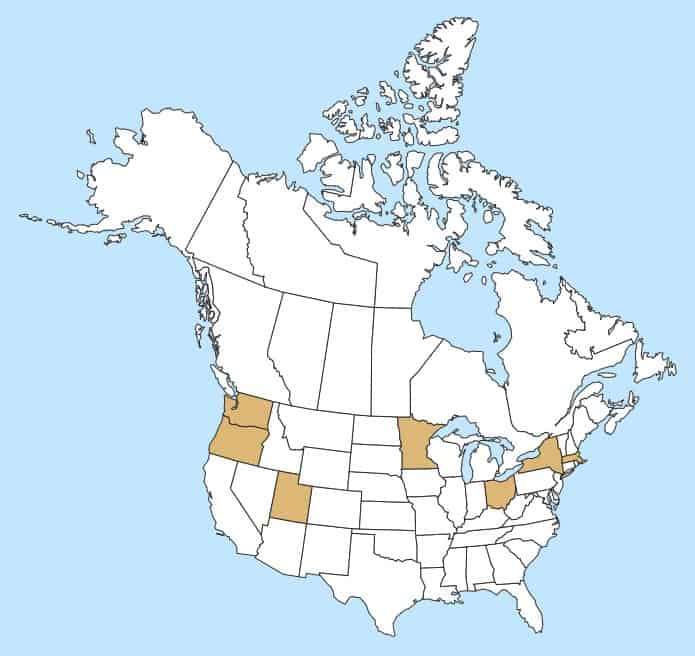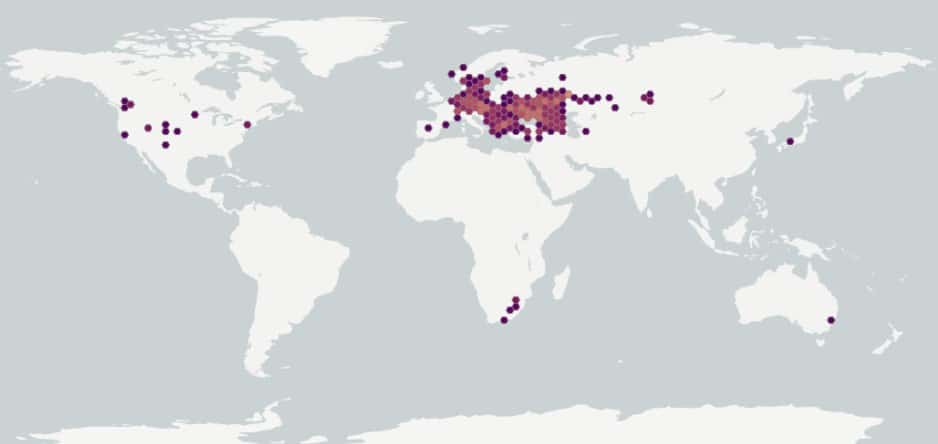Linaria genistifolia
Overview
Aperçu
Regulation :
Remarques Réglementation:
- CFIA Weed Seeds Order - Class 2: Primary Noxious Weed Seeds
Regulation Notes:
Distribution :
Répartition :
Native to central and eastern Europe and temperate Asia (USDA-ARS 2022). Introduced further in Europe, as well as in the United States, where it is present in Washington, Oregon, Utah, Minnesota, and some of the northeastern states (FNA 1993+; CABI 2022). Absent from Canada (Brouillet et al. 2010+).
Habitat and Crop Association :
Habitat et Cultures Associées :
Pastures, roads and disturbed areas (FNA 1993+; Darbyshire 2003).
Economic Use, cultivation area, and Weed Association :
Utilisation économique, zone de culture et association de mauvaises herbes :
Duration of Life Cycle :
Durée du cycle vital:
Perennial
Dispersal Unit Type :
Type d’unité de dispersion :
Seed
General Information
RENSEIGNEMENTS GÉNÉRAUX
Information about the biology of L. genistifolia is sparse, and the distribution in North America is unconfirmed (Sing et al. 2016). This lack of information about the species is largely due to uncertainty around its status as a species separate from L. dalmatica (Sing et al. 2016). Until recently, they were both subspecies of L. genistifolia (FNA 1993+) and much published information about L. genistifolia without clarification to the subspecies generally refer to L. dalmatica (FNA 1993+). Hybrids with L. dalmatica in a laboratory setting have been reported (Vujnovic and Wein 1997).
.
Identification
Identification
-
Capsule
Size
- Capsule length: 4–5 mm; width: 4 – 4.8 mm (FNA 1993+)
Shape
- Capsule is almost globose
Surface Texture
- Capsule surface is smooth
Colour
- Capsule is straw-yellow coloured
-
Seed
Size
- Seed length*: 0.6 – 0.8 mm; width: 0.4 – 0.5 mm
*Note: minimum and maximum of 10 seeds in a normal range of this species using image measurement (ISMA 2020)
From additional sources:
- Seed length: 0.8– 1.2 mm; width: 0.6 -1.0 mm (FNA 1993+)
Shape
- Seeds polygonal with three, four or five sides, generally with one tapered end
- Seeds appear wedge-shaped or trigonous in 2 dimensions
Surface Texture
- Seed faces densely covered with irregular ridges
Colour
- Seeds are shiny black or blackish- brown coloured
- Seeds generally have a metallic blue or silver reflection under bright lights
- Immature seeds are greyish white to yellowish white
Other Features
Hilum and hilum area
- Hilum is a small, oval-shaped opening along one of the seed edges
Other than hilum
- The seed edges are sharp and narrowly winged with a reticulate pattern, visible under 60x magnification
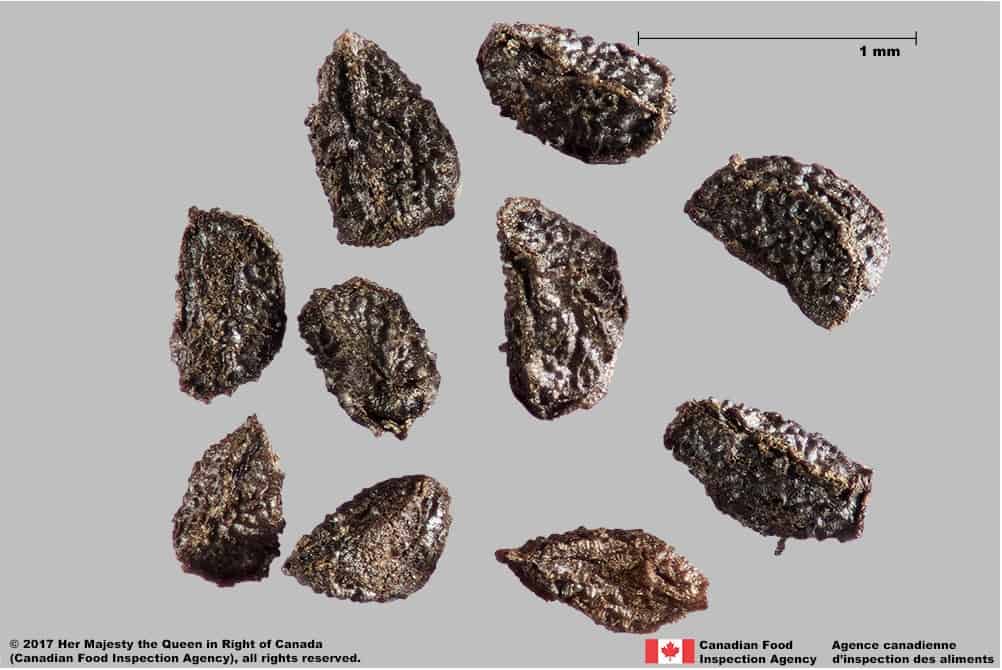
Broomleaf toadflax (Linaria genistifolia) seeds

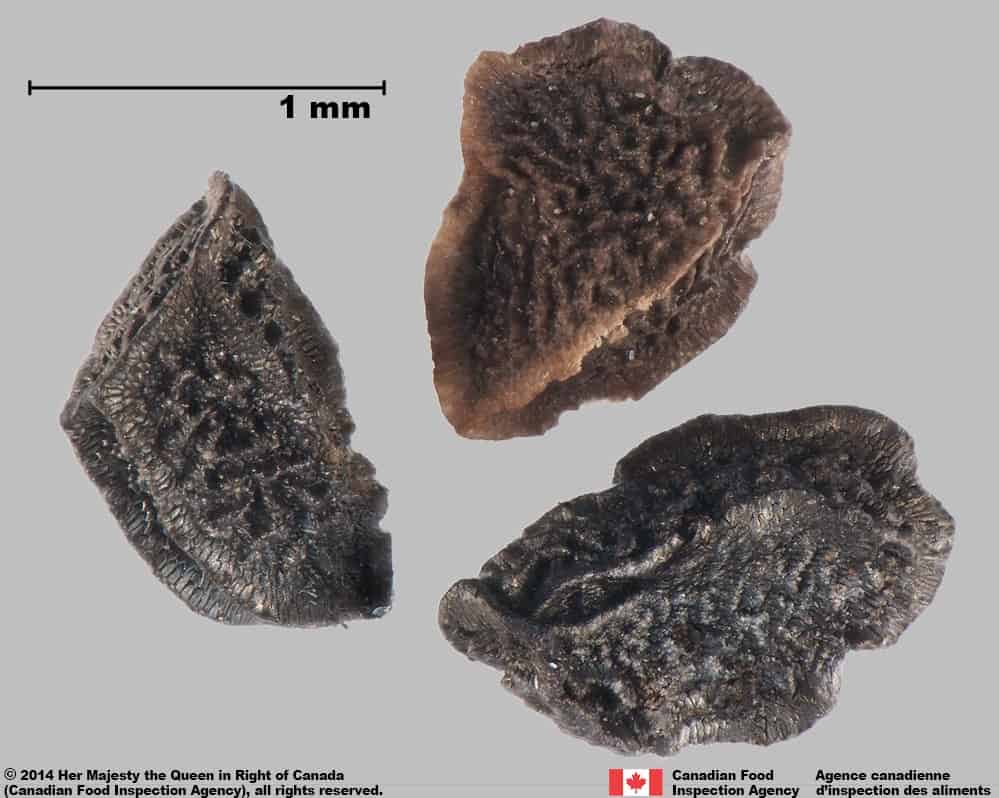
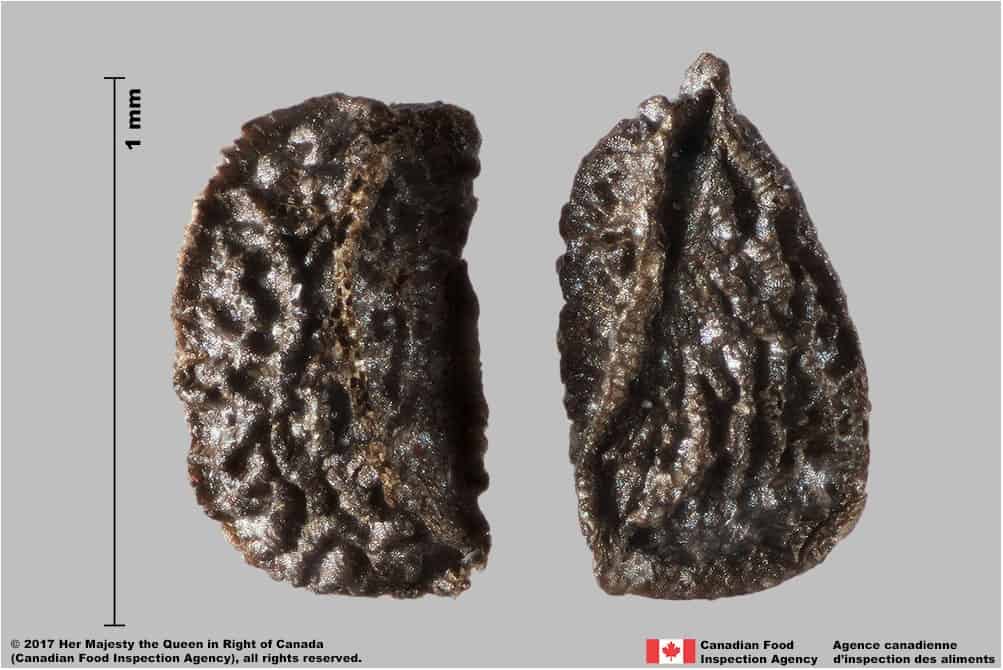
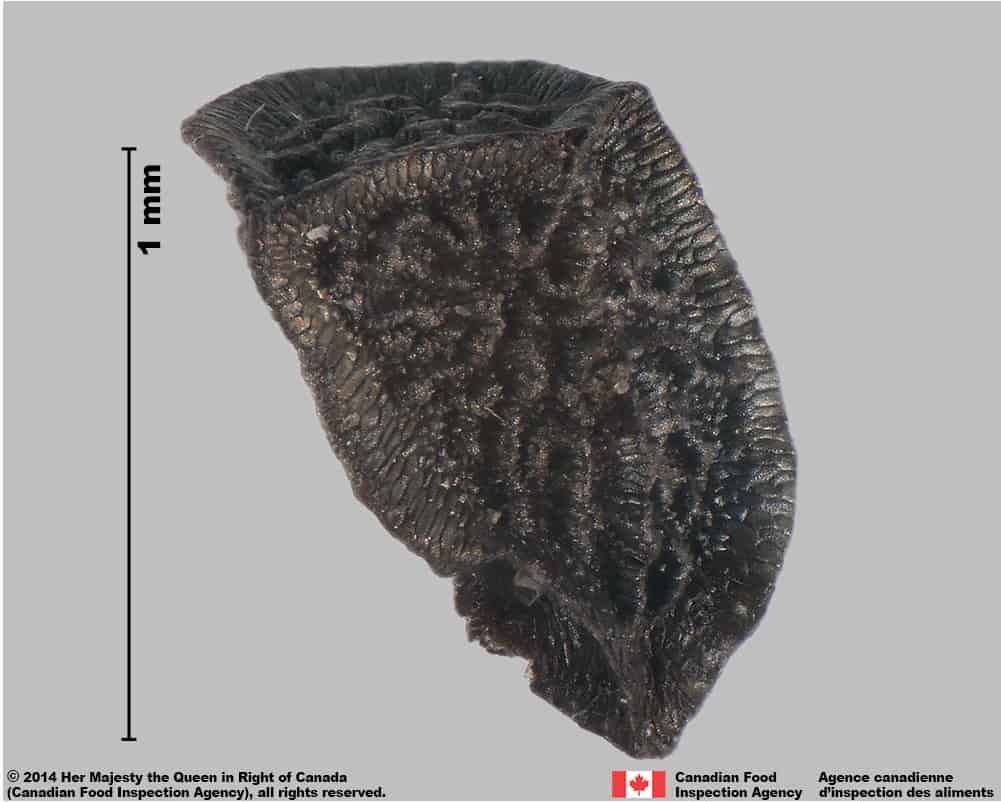
-
Embryo
Size
- Embryo partially fills the seed
Shape
- Embryo is linear shaped (Martin 1946)
Endosperm
- Endosperm is oily and translucent grey coloured
Other Features
- Embryo in an axial position
Identification Tips
CONSEILS POUR L’IDENTIFICATION
The seeds of Linaria species are generally black or dark brown coloured, many with a metallic reflection under bright lights, small sized, and round or polygonal shaped. L. genistifolia seeds are polygonal shaped along with similar shaped species such as L. repens, L. purpurea and L. dalmatica. Seeds of L. genistifolia are distinguished by the straight edges of the seed, one end generally narrowed, a metallic reflection, and the ridges on the flat faces generally more dense than similar species. L. dalmatica seed features, eg. size and surface texture, overlap with L. genistifolia, and seeds of these species may be difficult to distinguish from each other.

Broomleaf toadflax (Linaria genistifolia) seed




Additional Botany Information
AUTRES RENSEIGNEMENTS BOTANIQUES
Flowers/Inflorescence
- Flowers are light yellow or yellow (FNA 1993+)
- Flower length: 16 – 20 mm (FNA 1993+); 12 – 16 mm (Sing et al. 2016)
- Each flower has a narrow conical, nectar containing spur; length: 7-9 mm (FNA 1993+)
Vegetative Features
- In Europe a wide-leaved form and narrow-leaved form exist (Sing et al 2016)
- Plant also reproduces vegetatively by rhizomes (FNA 1993+)
Similar Species
ESPÈCES SEMBLABLES
Similar species are based on a study of seed morphology of various species, and those with similar dispersal units are identified. The study is limited by physical specimen and literature availability at the time of examination, and possibly impacted by the subjectivity of the authors based on their knowledge and experience. Providing similar species information for seed identification is to make users aware of similarities that could possibly result in misidentification.
Linaria dalmatica (L.) Mill. (Dalmatian toadflax)
L. dalmatica seeds are generally larger (length*: 1.1 – 1.6 mm; width: 0.7 – 1.1 mm) may be a shiny black colour, generally with a metallic brown reflection under bright lights. The irregular ridges have smaller interspaces and the winged edges have a striate pattern compared to L. genistifolia seeds with larger interspaces and a reticulate wing pattern. L. genistifolia flowers and seed capsules are generally smaller than those of L. dalmatica, the latter species having flowers significantly longer at 20 – 40 mm (Sing et al. 2016).
Linaria repens (L.) Mill. (striped toadflax)
L. repens seeds are generally larger (length*: 0.9 – 1.6 mm; width: 0.7 – 1.0 mm) then L. genistifolia seeds, but are a dull brownish colour, and have one curved edge, appearing almost three-sided. The seeds lack winged edges compared to L. genistifolia seeds.
*Note: minimum and maximum of 10 seeds in a normal range of this species using image measurement (ISMA 2020)
Click to select species
Cliquez pour sélectionner les espèces
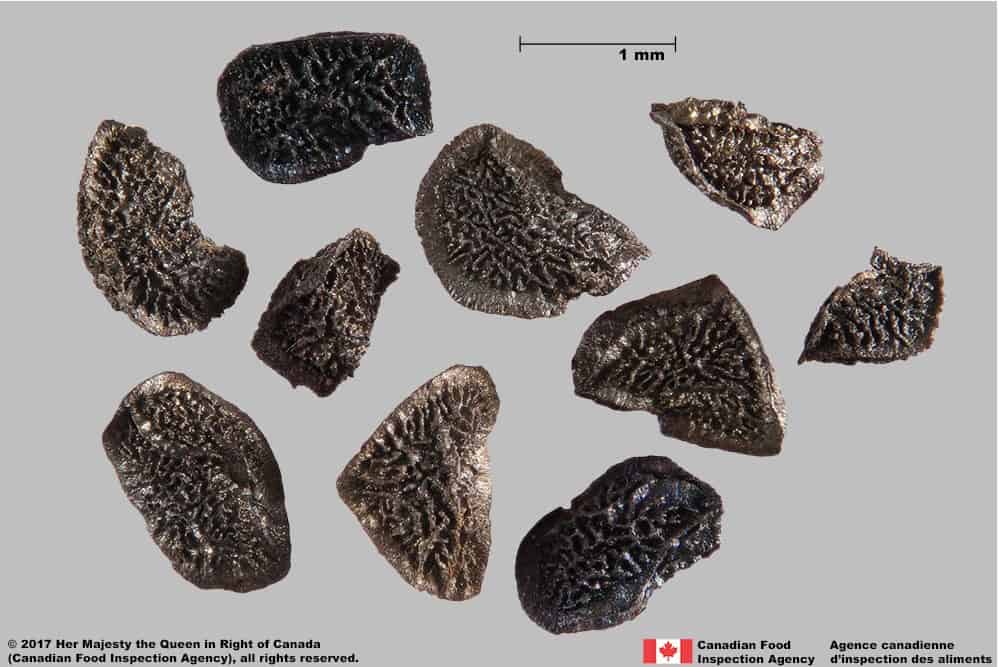
Linaria dalmatica
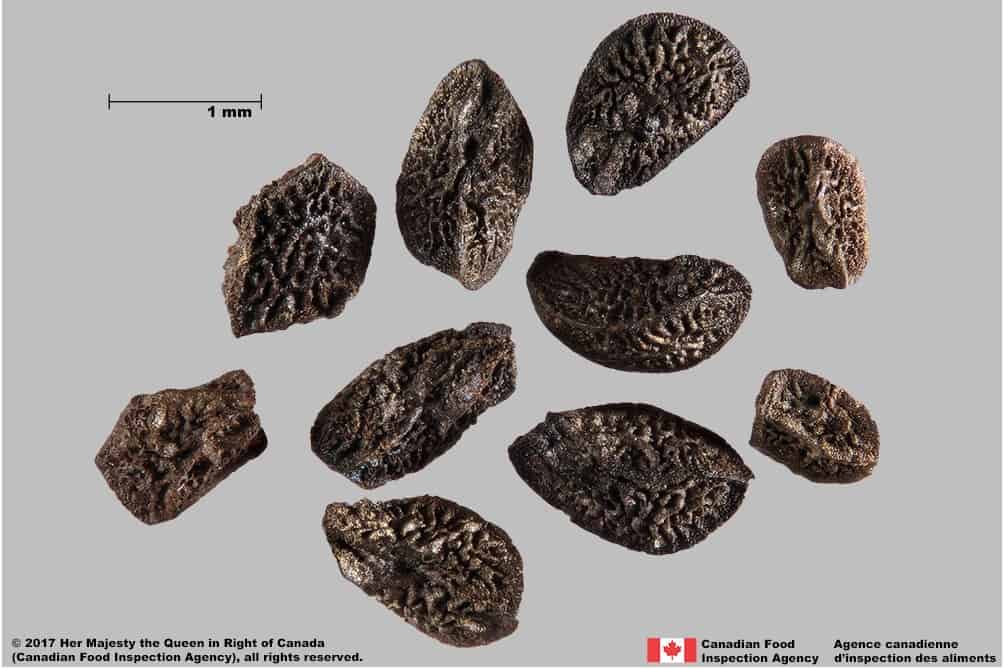
Linaria repens
Comparison Window
Fenêtre de comparaison
MAIN SPECIES
ESPÈCES PRINCIPALES
Linaria genistifolia

Linaria genistifolia
Plantaginaceae
Broomleaf toadflax (Linaria genistifolia) seeds
MAIN SPECIES
ESPÈCES PRINCIPALES
Linaria genistifolia

Linaria genistifolia
Plantaginaceae
Broomleaf toadflax (Linaria genistifolia) seeds
MAIN SPECIES
ESPÈCES PRINCIPALES
Linaria genistifolia

Linaria genistifolia
Plantaginaceae
Broomleaf toadflax (Linaria genistifolia) seeds
MAIN SPECIES
ESPÈCES PRINCIPALES
Linaria genistifolia

Linaria genistifolia
Plantaginaceae
Broomleaf toadflax (Linaria genistifolia) seed
SIMILAR SPECIES
ESPÈCES SEMBLABLES
Linaria dalmatica

Linaria dalmatica
Plantaginaceae
Dalmatian toadflax (Linaria dalmatica) seeds
SIMILAR SPECIES
ESPÈCES SEMBLABLES
Linaria dalmatica
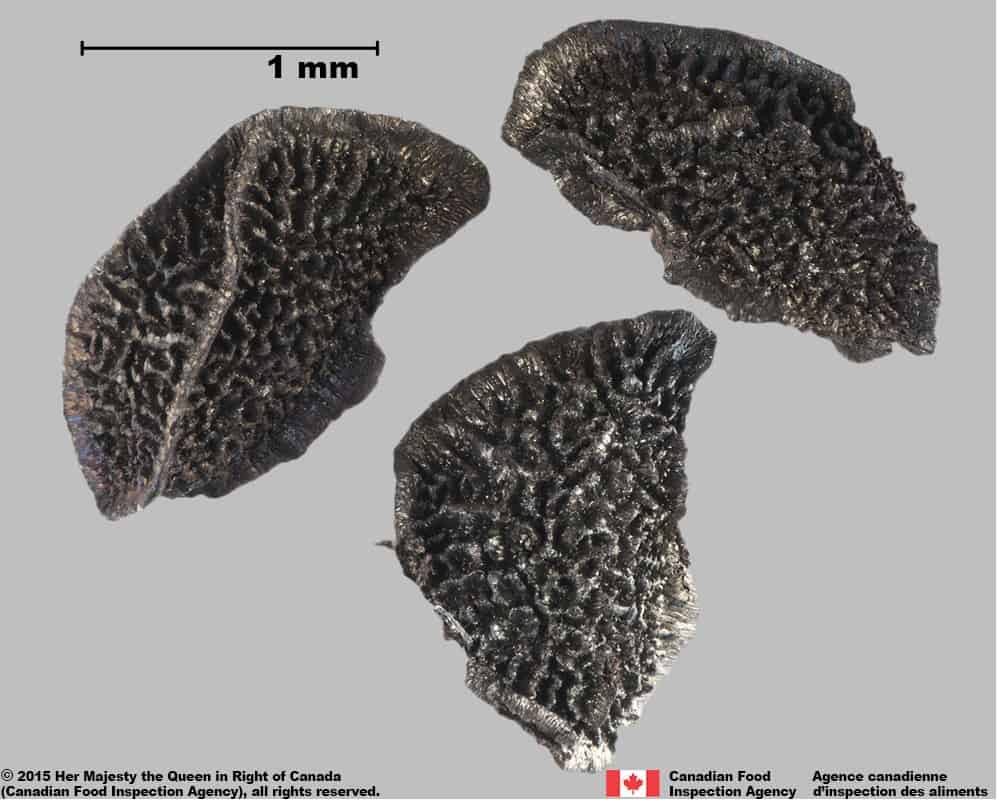
Linaria dalmatica
Plantaginaceae
Dalmatian toadflax (Linaria dalmatica) seeds
SIMILAR SPECIES
ESPÈCES SEMBLABLES
Linaria dalmatica
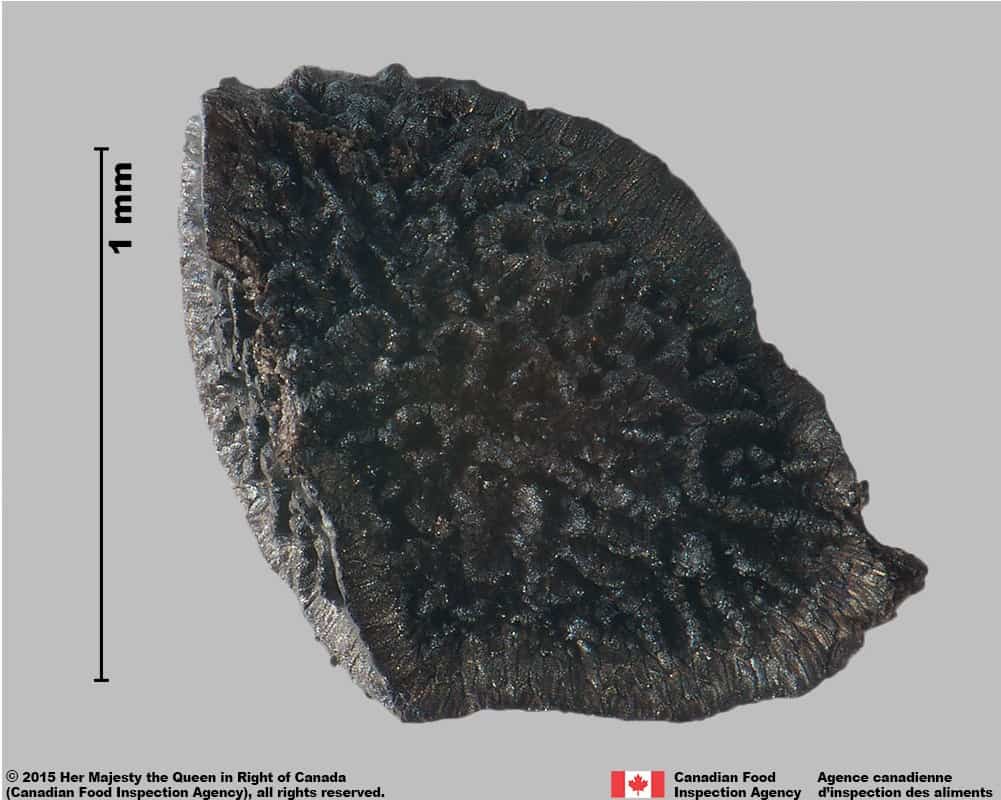
Linaria dalmatica
Plantaginaceae
Dalmatian toadflax (Linaria dalmatica) seed
SIMILAR SPECIES
ESPÈCES SEMBLABLES
Linaria dalmatica
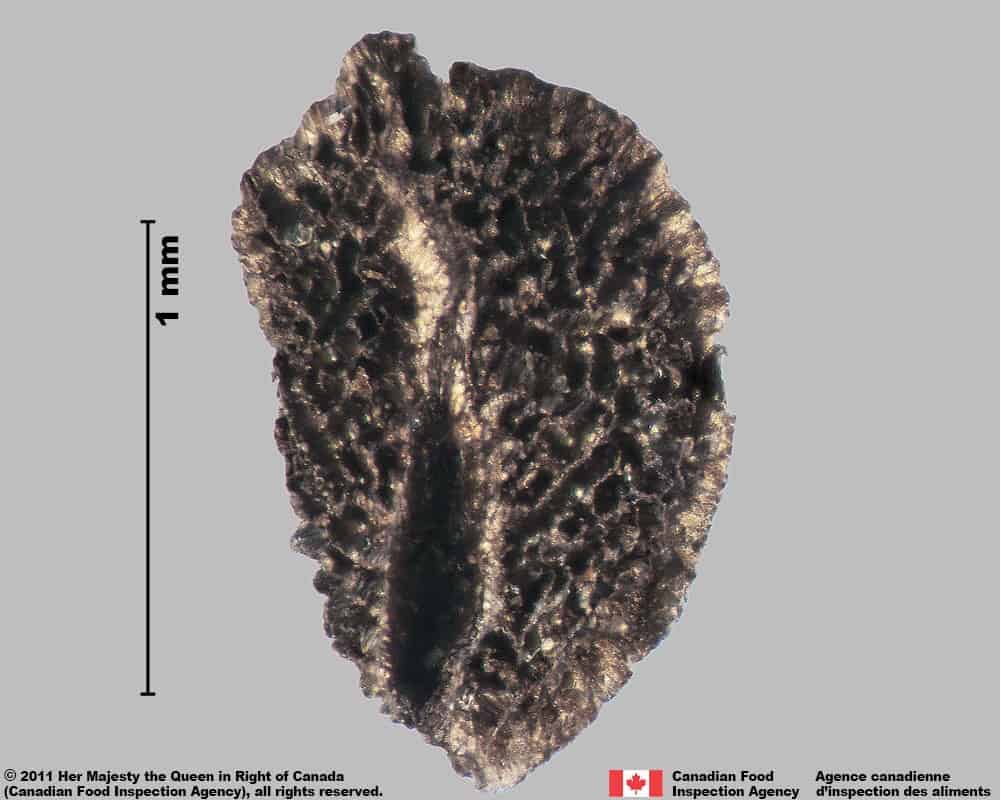
Linaria dalmatica
Plantaginaceae
Dalmatian toadflax (Linaria dalmatica) seed showing bronze highlights
Need ID Help?
Besoin d’aide pour l’identification?
Reference(s)
Référence(s)
Brouillet, L., Coursol, F., Meades, S. J., Favreau, M., Anions, M., Bélisle, P. and Desmet, P. 2010+. VASCAN, the database of vascular plants of Canada. http://data.canadensys.net/vascan/ Accessed June 13, 2022.
Centre for Agriculture and Bioscience International (CABI). 2022. Invasive Species Compendium, CAB International, Wallingford, UK. https://www.cabidigitallibrary.org/journal/cabicompendium Accessed March 21, 2022.
Darbyshire, S. J. 2003. Inventory of Canadian Agricultural Weeds. Agriculture and Agri-Food Canada, Research Branch. Ottawa, ON.
Flora of North America (FNA) Editorial Committee, eds. 1993+. Flora of North America North of Mexico [Online]. 22+ vols. New York and Oxford. http://beta.floranorthamerica.org. Accessed December 29, 2022.
Global Biodiversity Information Facility (GBIF) Secretariat. 2022. https://doi.org/10.15468/39omei Accessed via https://www.gbif.org/species/5415013 Accessed December 29, 2022.
Government of Canada (GC). 2016. Canadian Weed Seeds Order. https://laws-lois.justice.gc.ca/eng/regulations/SOR-2016-93/page-2.html (English) https://laws-lois.justice.gc.ca/fra/reglements/DORS-2016-93/page-2.html (French)
International Seed Morphology Association (ISMA). 2020. Method for Seed Size Measurement. Version 1.0. ISMA Publication Guide.
Martin, A.C. 1946. The comparative internal morphology of seeds. The American Midland Naturalist 36: 513-660.
Plants of the World Online (POWO). 2022. Facilitated by the Royal Botanic Gardens, Kew. Published on the Internet; http://www.plantsoftheworldonline.org/ Accessed June 13, 2022.
Sing, S.E., De Clerck-Floate, R.A., Hansen, R.W., Pearce, H., Randall,C.B.,Toševski, I. and Ward, S.M. 2016. Biology and Biological Control of Yellow and Dalmatian
Toadflax. 3rd Edition. U.S. Forest Service, Forest Health Technology Enterprise Team Morgantown, WV. 141 pp.
Tropicos.org. 2022. Missouri Botanical Garden. https://tropicos.org Accessed June 13, 2022.
U.S. Department of Agriculture-Agricultural Research Services (USDA-ARS). 2022. Germplasm Resources Information Network (GRIN), https://npgsweb.ars-grin.gov/gringlobal/taxon/taxonomysimple.aspx Accessed June 13, 2022.
Vujnovic, K. and Wein, R. W. 1997. The biology of Canadian weeds. 106. Linaria dalmatica (L.) Mill. Canadian Journal of Plant Science 77: 483–491



